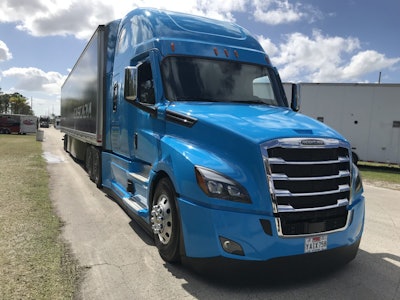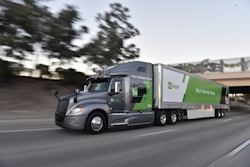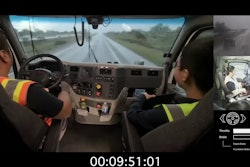 The 2020 Cascadia tractor, set for production this fall, will enable SAE Level 2 automated driving and will become the first production model to hold such distinction in North America.
The 2020 Cascadia tractor, set for production this fall, will enable SAE Level 2 automated driving and will become the first production model to hold such distinction in North America.Despite a tech- and aero-rich overhaul just two years ago, Freightliner is again updating its flagship Cascadia tractor for model-year 2020, slated to begin production this fall. As reported last month, the new Cascadia will come standard with SAE Level 2 automated functionality, meaning the truck can accelerate, decelerate and steer independently of an operator.
Level 2 automation still requires a human operator, and Level 2 vehicles are still mostly controlled by a human driver. The Cascadia’s semi-autonomous capabilities function like a sophisticated cruise control that maintains its lane and following distance in on-highway settings.
Overdrive Equipment Editor Jason Cannon was able to take the 2020 Cascadia for a test run in south Florida last week. You can read his full recap of the drive — and how the autonomous functions work — at this link. As he notes, the semi-autonomous Cascadia won’t replace any driving jobs. It simply helps drivers do their work more easily and stands watch over the truck’s surroundings to help prevent crashes.
Here’s a summary of Cannon’s test drive:
The Detroit Assurance 5.0 platform is the brain that enables automated driving. Adaptive Cruise Control (ACC) handles acceleration and deceleration while Active Lane Assist handles automated steering input.
Detroit Assurance 2.0 and 4.0 were strictly radar-based, which provided collision mitigation and adaptive cruise control capabilities. The 5.0 version marries the bumper-mounted radar with a new high-definition (HD) camera affixed atop the windshield to provide improved object recognition.
In low-visibility conditions, like fog, the system relies more heavily on the radar rather than simply suspending functionality. The HD camera controls safety functions like lane departure warning while also handling sign recognition. Speed limits are shown in the driver information display (DID) and update as the camera recognizes they have changed. The camera can also recognize passing zone signs and truck route warnings.
Through the updated Detroit Assurance 5.0, ACC now brakes to 0 mph and Active Brake Assist 5.0 – standard within Detroit Assurance 5.0 suite – includes full braking on moving and stationary objects. ACC to 0 allows the driver to keep cruise control enabled in congested conditions as the truck creeps along with the pace of traffic, including fully stopping the vehicle when the need arises.
Active Lane Assist is the system that enables Level 2 automated steering. It consists of Lane Keep Assist (LKA) and Lane Departure Protection (LDP). When a driver switches on ACC, the system automatically engages LKA, which uses small steering gear movements to keep the truck centered in its lane. The driver can also allow for a slightly left or right bias. With LDP, if the truck drifts without the turn signal engaged, the system will counter-steer the tractor back into its lane and give the driver audible and visual warnings.
While the automated steering will do its best to keep the truck centered, it will cede control to the driver. If the platform thinks the truck should be centered but the driver decides it needs to move to the left or right – maybe to give a construction crew some breathing room, for example – the system doesn’t fight the driver. The truck simply moves over as it traditionally would. Active braking works the same way, always letting the driver make the final call.
When highway lane markings were well-defined, Active Lane Assist worked flawlessly. Wheel input from the system was subtle and precise. I cruised along for long stretches with my feet firmly planted to the floor and hands only resting on the wheel.
I enjoyed using this feature and can see the benefits of having the automated support over 400, 500 or 600 miles per day, hauling freight several days per week.
Detroit Assurance 5.0 is a driver assistance platform, not a driver replacement system. As such, it requires that the driver remain actively engaged at all times. Sensors in the steering wheel detect if a driver has taken their hands off the wheel and offer a series of audible warnings in escalating annoyance as a reminder to put your hands back on the wheel. If the driver ignores the persistent screeching requests to grab the wheel, LKA will disable. Lane Departure Protection remains enabled in order to keep the tractor within its lane, but it will bounce from right line to left line in an effort to re-engage the driver.
–Jason Cannon










